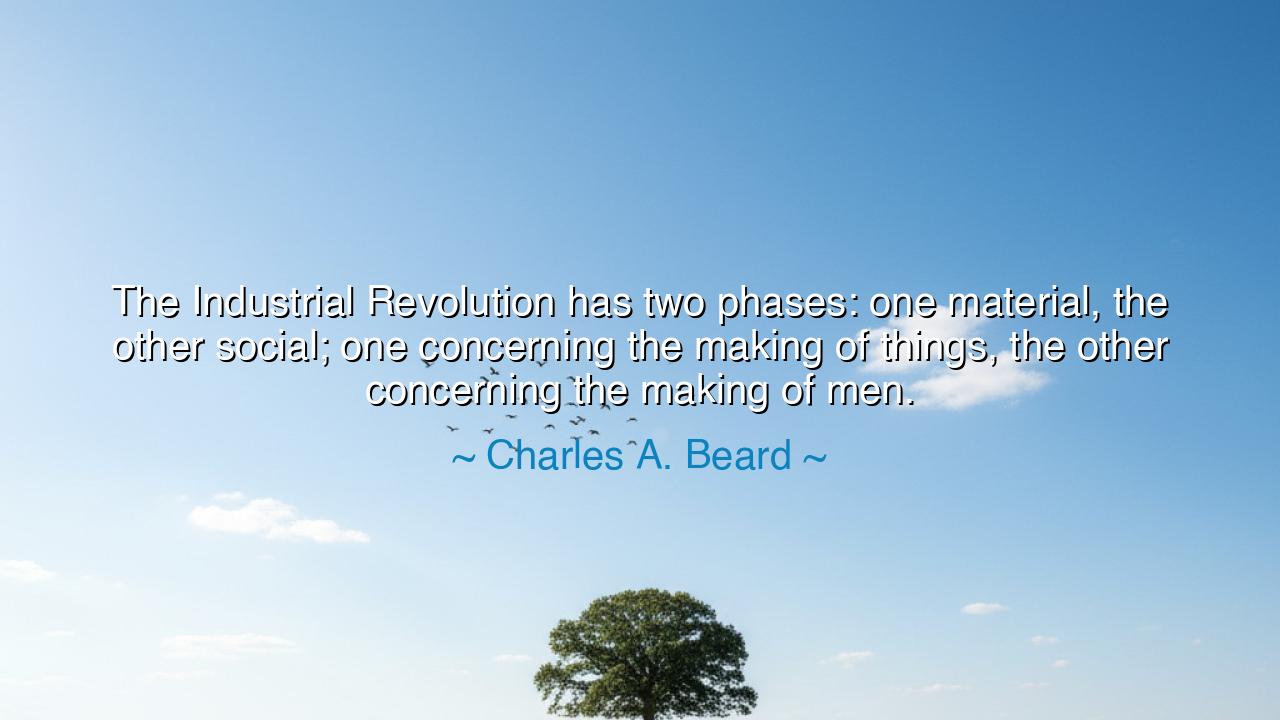
The Industrial Revolution has two phases: one material, the other
The Industrial Revolution has two phases: one material, the other social; one concerning the making of things, the other concerning the making of men.






Hear, O children of history, the words of Charles A. Beard, who declared: “The Industrial Revolution has two phases: one material, the other social; one concerning the making of things, the other concerning the making of men.” This utterance is not a cold description of machines, but a cry of wisdom, reminding us that no transformation of industry is ever complete until it reshapes the spirit of humanity. For the whirring of engines, the rise of factories, the hum of production—these are but the outer skin of a revolution. The deeper change lies in the heart, in the lives of men and women, in the reordering of society itself.
The first phase, the material, is plain to see. It was the age when coal fed the furnaces, when iron yielded to steel, when steamships and railways bound the earth with iron veins. Out of it came the multiplication of wealth, the abundance of goods, the triumph of invention. Looms wove garments in hours that once took months, machines carved wood and stone faster than a hundred hands. The making of things became swift, cheap, and plentiful. Yet this was but the outward half of the revolution.
The second phase, the social, was more subtle yet more profound. For the factory did not only shape goods—it shaped men. The farmer who once tilled his own land became the worker bound to the clock. The child who once roamed the fields was drawn into the mill. The family, once a unit of labor, was scattered by shifts and wages. Out of this grew new classes, new struggles, new cries for justice. Thus, the Industrial Revolution was not merely a revolution of machines, but of the human soul, demanding new laws, new rights, and new ways of living together.
Consider the story of the Luddites, workers in England who, seeing their crafts displaced by machines, rose in rebellion. They smashed the looms, not out of hatred for invention, but out of despair that their way of life was vanishing. To them, the material revolution threatened the dignity of men. And though history often mocks them, their cry was a warning: that progress in the making of things must be balanced by progress in the making of men, or else society collapses into misery.
And yet, out of the struggles came growth. Trade unions arose, demanding fair wages and safe conditions. Reformers fought to end child labor and grant education to the young. Philosophers like Karl Marx and John Stuart Mill sought to interpret the new order, while leaders like Robert Owen experimented with communities built upon cooperation rather than exploitation. The social phase of the revolution was a long and bitter birth, yet from it came the foundations of modern society: labor rights, public schools, and the idea that progress must serve not only the few but the many.
Thus, O listener, the meaning of Beard’s words shines clear: every great change has two sides, the outer and the inner, the material and the social. To build machines is not enough; we must also build justice. To multiply goods is not enough; we must also multiply dignity. The making of things is hollow unless it is joined to the making of men, for what use is abundance if humanity itself is starved of fairness and meaning?
Therefore, let this teaching be carved upon your heart: in your own age of revolution—whether of technology, of information, or of thought—do not rejoice in the material alone. Look to the social, to the way it shapes lives, families, and souls. Ask not only “what can we make?” but also “what kind of people shall we become by making it?” In this lies the true measure of progress.
Practical action lies before you. Embrace invention, but demand that it uplift humanity. Support technologies that serve the common good, not just profit. Guard the dignity of workers, cherish the education of children, and ensure that each change in the making of things also advances the making of men. For only then will revolutions bear fruit worthy of the name—fruit that nourishes not just the body, but the soul of civilization.






AAdministratorAdministrator
Welcome, honored guests. Please leave a comment, we will respond soon